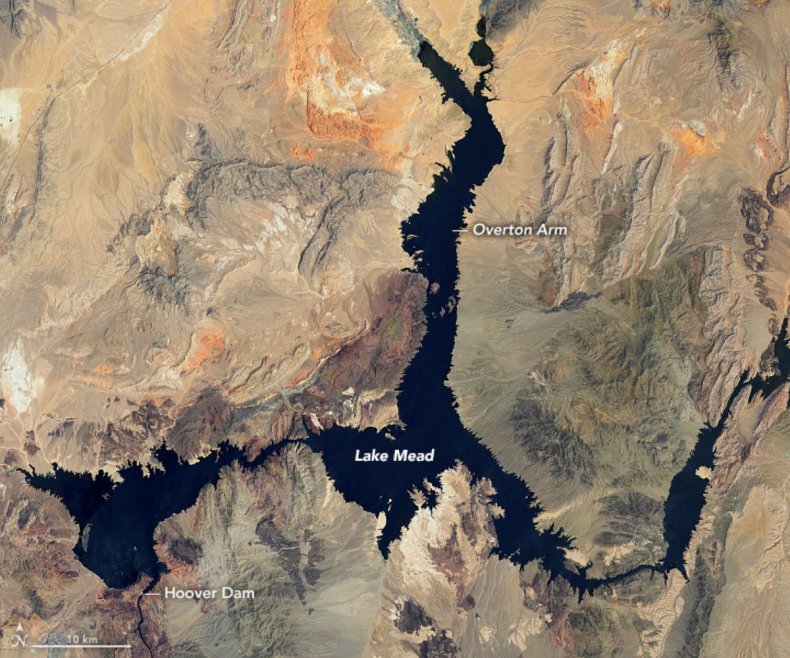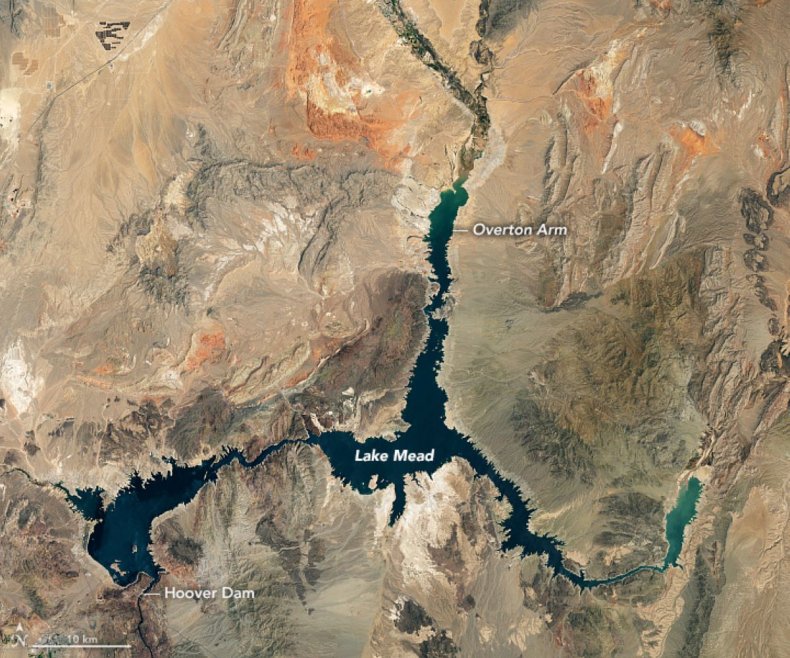Lake Mead Water Levels Set to Reach All Time Low in 2023
Lake Mead's water levels could reach an all-time low in 2023, projections from the Bureau of Reclamation show.
The Colorado River reservoir—which has been rapidly drying up due to the ongoing megadrought gripping Nevada and neighboring states—could reach lows of 1,024.47 feet by November, a study released by the Bureau on January 19 said.
Lake Mead's water levels have risen slightly from 1,042.97 feet at the beginning of December, to 1,045.80 feet as of January 19. This is due to recent heavy rainfall and winter storms that swept across Nevada and the neighboring states. But the recent projections show it will take a lot more than rainfall to change the dire outlook for the lake.


Drag slider
to compare photos

Elizabeth Koebele, an associate professor of political science at the University of Nevada, Reno, told Newsweek: "This is a Colorado River problem — what I call a "system problem" — and we'd be remiss to think of it otherwise. Lake Mead is mainly filled by releases from an upstream reservoir called Lake Powell, which captures runoff in the Upper Colorado River Basin. These reservoirs were built to store water in wet years in order to mitigate occasional drought. However, due to a combination of prolonged drought over the last two decades, increasing aridification from climate change, and a set of historical laws that has promoted overuse of Colorado River water in the Lower Basin, both reservoirs are at their lowest levels since being constructed."
Water levels in Lake Mead reached the lowest they have ever been last July, at 1,040.8 feet. The Lake hadn't reached such a low level since it was constructed in the 1930s.
The new projections also estimate that the level will drop again to 1,040.83 feet in March 2023. From there, the Bureau projected the water levels could keep declining, before reaching the low point of 1,024.47. It then projects water levels will rise slightly at the beginning of 2024 to 1,029.90.
Although these are only estimates, the lake has been in a dire state for years, meaning it is likely that water levels will drop further than they already have in the coming year.
"A few big winter storms aren't going to fix the Colorado River Basin's crisis. Aridification has led to low soil moisture and reduced runoff efficiency—meaning that even if we get big storms, less of it becomes runoff in the river. Even a few really wet years probably wouldn't refill the reservoirs, given how low they are and how temperatures continue to rise (causing more evapotranspiration)," Koebele said.
If water levels keep declining, it could mean bad things for surrounding cities and communities that rely on Lake Mead for water. Southern Nevada relies on Lake Mead for 90 percent of its water supply.
The reservoir is also formed by the Hoover Dam, which produces about 4 billion kilowatt-hours of hydroelectric power every year. The lake may eventually reach dead pool, which is at 895 feet, when the water would no longer flow past the dam.
Koebele said there are policies being put in place such as the Drought Contingency Plan. This cuts water deliveries made to Lower Basin states, which include Arizona, California, Nevada, New Mexico and Utah.
"We also have two important decisions coming up. One, at the end of January 2023, the Basin States are expected to submit a new plan to the federal government, who is undertaking a Supplemental Environmental Impact Statement (SEIS) process under the National Environmental Policy Act (NEPA), for reducing water use by 2-4 million acre feet," Koebele said. "Two, many of the current policies that govern Colorado River allocations, including the DCP and other shortage-sharing guidelines, expire in 2026, so the states and federal government are simultaneously beginning a process to develop rules for the next 20 years of Colorado River management that can help mitigate some of these issues. Managing for both short-term emergencies and long-term sustainability makes this situation particularly difficult."
Do you have a tip on a science story that Newsweek should be covering? Do you have a question about Lake Mead? Let us know via [email protected].










































